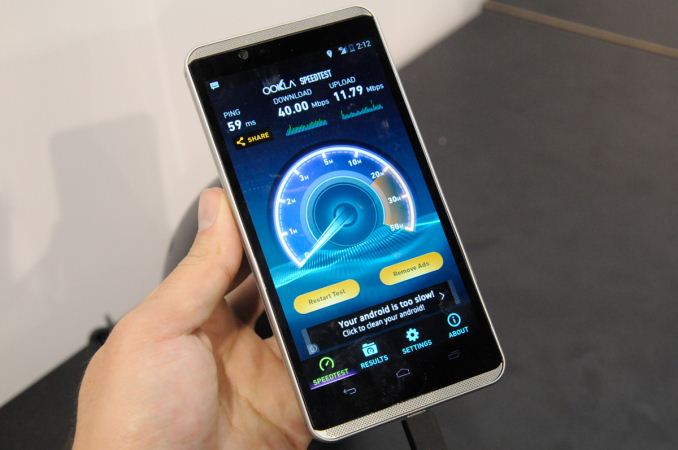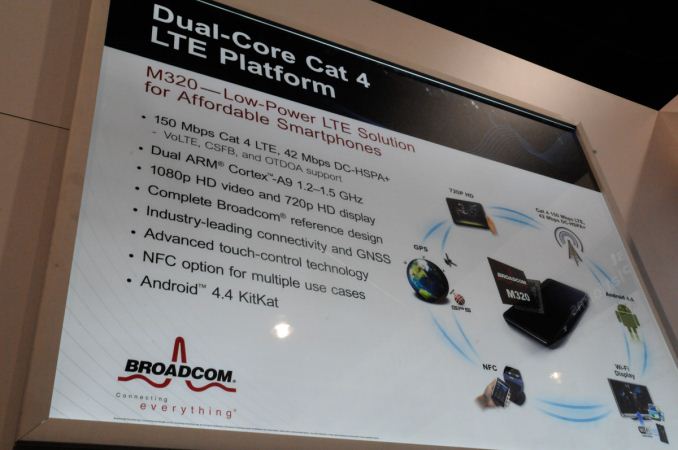Broadcom Teases Upcoming Cat 6 LTE Multimode Modem, M320 SoC with LTE
by Brian Klug on January 11, 2014 6:38 PM EST- Posted in
- Trade Shows
- LTE
- CES
- Broadcom
- CES 2014

Last year at CES we took a look at Broadcom's LTE modem portfolio, where the company showed off a Cat 4 LTE baseband doing 10+10 MHz carrier aggregation, before being formally announced at MWC. Since then a number of things have changed, including Broadcom's acquisition of LTE and SoC related Renesas Electronics assets, and subsequent restructuring of Broadcom's LTE modem plans. Its own LTE modem which we saw last year has been shelved in favor of a plan forwards with an M320 SoC with multimode capabilities and an upcoming standalone LTE modem.
At CES 2014, Broadcom showed off its M320 SoC which was based on the Renesas SoC platform. M320 combines two ARM Cortex A9 CPUs clocked between 1.2 and 1.5 GHz, PowerVR 5XT GPU, and Cat 4 LTE modem with DC-HSPA+ and GSM multimode capabilities. Broadcom prepared a reference design turnkey phone based on the M320 platform and showed it attached to AT&T and T-Mobile LTE on the show floor, and allowed me to run a few speedtests. The platform is already slated to be productized by Samsung in an upcoming smartphone which was under development even before the acquisition completed.
In addition, Broadcom teased an upcoming Cat 6 (300 Mbps) LTE modem cabled up to an Anritsu base station emulator showing 20+20 MHz carrier aggregation and delivering the expected 300 Mbps speeds on the downlink. Just like last year, it's easy to speculate that Broadcom might formally announce the name and details of this upcoming multimode LTE modem around MWC, although Broadcom isn't saying anything specific.


















18 Comments
View All Comments
SlyNine - Saturday, January 11, 2014 - link
That 4GB cap might as well be 4KB.flyingpants1 - Saturday, January 11, 2014 - link
Who cares? Consistent 10-20mbit for my CELL PHONE is just fine. 300mbps is just ridiculous. Please stop.I wish they'd stop messing with screens and LTE, and fix speakers and battery life.
danstek - Sunday, January 12, 2014 - link
It's not about an individual having/needing 300 Mbps on a phone. That's the wrong way to look at it. Faster link speeds can benefit things like power consumption (race to sleep concept, shorter duty cycles, etc). And having more capacity and efficiency is a good thing. Why would you tell them to stop?SodaAnt - Monday, January 13, 2014 - link
Because I've found that above 50 Mbps, any increases rarely decrease page loading time, except when there are a LOT of big images hosted on fast servers. Otherwise, loading multiple files from slower servers becomes the bottleneck.mach665 - Monday, January 13, 2014 - link
That speed is the mobile cell capacity. You have to share it with other users in the same cell. It maybe high for a single user, but shared with tens or even hundreds of other users, it's not that high any more. For 300Mbps LTE, if there are 100 users using internet at the same time, each user can only get about 3Mbps.Even if each user doesn't need more band width. The operator still wants to increase the cell capacity by upgrading to more advanced LTE technology. Thus, it can serve more users per cell and make more money.
So, you see, the high speed is a marketing tool to attract end users. It is actually more for the operators themself.
Acarney - Sunday, January 12, 2014 - link
Race to sleep could actually help battery life, I figure that's going to be the big internal marketing for these crazy high speed LTE chips. Speakers, ya, I would LOVE speaker phone to be louder and better quality (both for when using speaker phone in the car, or listening to a podcast without headphones)r3loaded - Sunday, January 12, 2014 - link
Once upon a time, a 1.5Mbps T-1 connection was considered ridiculous too, with 56K modems being just fine for most people.Besides, Broadcom is in the ARM SoC and network communications business, I don't think there's much they can do about speakers or battery life apart from improving the efficiency of their products. Which just happens to be exactly what they're doing here with each generation.
Murloc - Sunday, January 12, 2014 - link
I'm sure they're incerasing efficency too since that's always a problem.Speakers? They don't get fixed because there's no request for pricey speakers which are going to be crappy anyway since they have to fit in a phone.
Just use earphones, that's what people do when they want to listen to music.
For talking, you don't need higher quality than what is currently available.
sadlkjh - Monday, January 13, 2014 - link
well, get a couple of thin modems, have them share your data plan and bye bye cable.hrrmph - Sunday, January 12, 2014 - link
Glad they got the 3G GSM in there.Any idea how close this will come to covering most of the 4G-LTE bands necessary for getting around the world? You know... through most of the 200 sovereign nations camped out on this beautiful blue orb were all riding around on?
Or is this another only-works-at-4G-speeds-in-the-lower-48 thing?